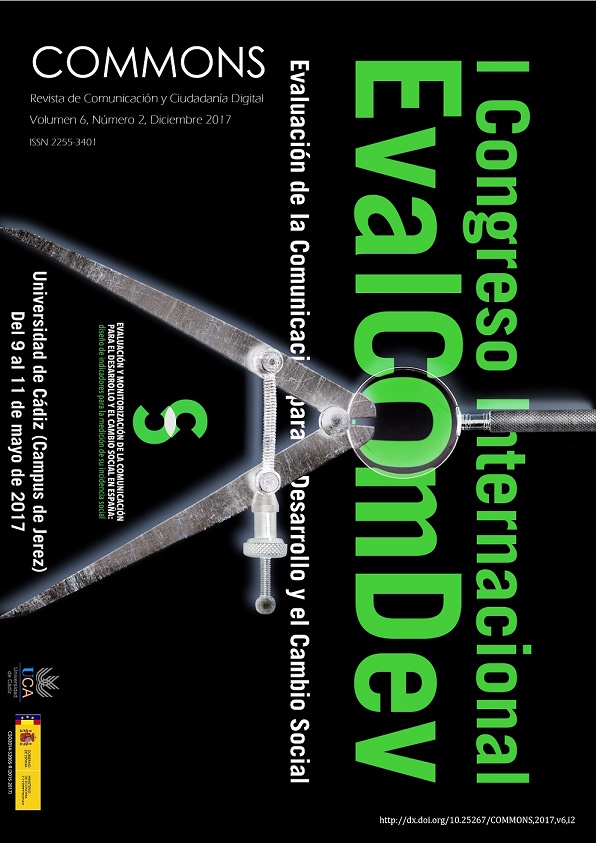Análisis y relatos de experiencias de comunicación participativa en radios comunitarias en India / Analysis and Reports of Participatory Communication Experiences in Community Radios in India

Info
Abstract
From a critical perspective of communication for development and social change and taking as a reference a new look at the Communicology of Liberation of Luis Ramiro Beltrán (1981), this presentation analyses experiences and models of horizontal communication of community radios in India. It aims at knowing from the practice, the ways in which previously excluded and silenced communities are being engaged in the communication process. This paper presents the results of a study on community participation in participative communication practices initiated by three community radios in India. This analysis tries to reflect the various ways in which the three radio stations approach the process of two-way communication with the populations and communities they serve.
Keywords
Downloads
How to Cite
License
Authors who have published with this journal accept the following terms:
- Authors shall retain their copyright and guarantee the journal the right of first publication of their work, which shall simultaneously be subject to the Creative Commons 3.0 Recognition License, which allows third parties to share the work as long as its author and first publication are indicated in this journal.
- Authors may adopt other non-exclusive licensing agreements for the distribution of the published version of the work (e.g., depositing it in an institutional telematic archive or publishing it in a monographic volume) provided that the initial publication in this journal is indicated.
- Authors are permitted and encouraged to disseminate their work via the Internet (e.g., in institutional telematic archives or on their website) before and during the submission process, which may lead to interesting exchanges and increased citations of the published work. (See The Effect of Open Access).
References
AMARC. (n.d.). ¿Qué es una Radio comunitaria? Recuperado el 21 de enero de 2016, de http://www.amarc.org/?q=es/node/131
AMARC. (2009). Principios para un marco regulatorio democrático sobre radio y TV comunitaria. (2009). Montevideo. Recuperado de http://www.amarc.org/documents/14Principios_Legislacion_Radiodifusion_Comunitaria_ES.pdf
BELTRÁN SALMÓN, L. R. (1981). Adiós a Aristóteles: La comunicación “horizontal.” Comunicación Y Sociedad, (6), 5–35.
CENSUS OF INDIA. (2011). State of Literacy. Recuperado de http://censusindia.gov.in/2011-prov-results/data_files/india/Final_PPT_2011_chapter6.pdf
CHAPARRO ESCUDERO, M. (2015a). Claves para repensar los medios y el mundo que habitamos. La distopía del desarrollo. Bogotá: Desde abajo.
CHAPARRO ESCUDERO, M. (2015b). Del pensamiento de Luis Ramiro Beltrán a las Epistemologías de la liberación y la alteridad. Revista Internacional de Comunicación Y Desarrollo, (3), 143–153. https://doi.org/http://dx.doi.org/10304/ricd.1.3.3062
DRÈZE, J., & SEN, A. (2013). Democracia, desigualdad y razonamiento público. In Una gloria incierta: India y sus contradicciones (pp. 271–304). Madrid: Taurus.
FREIRE, P. (1970). Pedagogía del oprimido. Montevideo: Tierra Nueva.
LEWIS, P. M. (2003). Est-ce que ça marche? L’Observation et l’évaluation des radios communautaires. In Audiences, publics & pratiques radiophoniques (pp. 83–94). Pessac: MSHA.
MALIK, K. K. (2015). Our media, our principles. Journalism Studies, 1–14. https://doi.org/10.1080/1461670X.2015.1054195
MANDER, H. (2015). Looking Away: Inequality, Prejudice and Indifference in New India. New Delhi: Speaking Tiger.
MIB. Policy Guidelines for setting up Community Radio Stations in India (2006). New Delhi: MIB. Recuperado de http://mib.nic.in/writereaddata/html_en_files/crs/CRBGUIDELINES041206.pdf
MOSELEY, C. (Ed.). (2010). Atlas de las lenguas del mundo en peligro (3ra ed.). París: Ediciones UNESCO. Recuperado de http://www.unesco.org/culture/languages-atlas/es/atlasmap.html
ONEWORLDFOUNDATION, & MIB. (2016). EK duniya anEK Awaaz. One World, Many Voices. Recuperado de http://edaa.in/
PAVARALA, V. (2013). Communities are entitled to news. Recuperado el 21 de enero de 2016, de http://www.thehoot.org/media-watch/community-media/communities-are-entitled-to-news-7097
PAVARALA, V. (2015). Community Radio and its Discontents in India: Blurred Development Visions. In IAMCR 2015. Hyderabad.
PAVARALA, V., & MALIK, K. K. (2007). Other Voices: The Struggle for Community Radio in India. New Delhi: Sage. Recuperado de http://www.sagepub.in/books/Book232383?siteId=sage-india&prodTypes=any&q=other+voices&fs=1
SESHU, G. (2017). New policy dismays Community Radio activists. The Hoot. Recuperado de http://www.thehoot.org/media-watch/community-media/new-policy-dismays-community-radio-activists-9935
SHARMA, S., & UPADHYAY, V. (2017, February). Fires in Uttarakhand jungles spark fears of another blaze like last year. Times of India. Dehradun. Recuperado de http://timesofindia.indiatimes.com/city/dehradun/no-lessons-learnt-fires-in-ukhand-jungles-spark-fears-of-another-blaze-like-last-year/articleshow/57225474.cms
UNDP, & VOICES. (2004). Community Radio in India- Step by Step.


